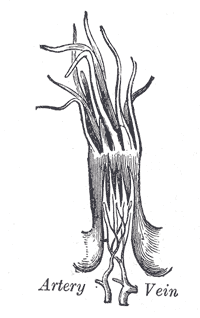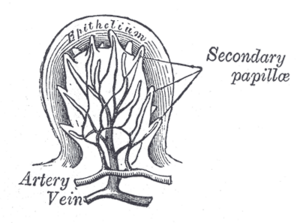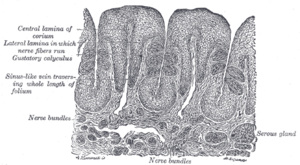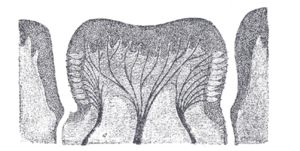Lingual papillae facts for kids
Quick facts for kids Lingual papillae |
|
|---|---|
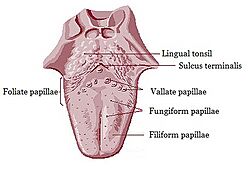 |
|
| Anatomic landmarks of the tongue. Filiform papillae cover most of the dorsal surface of the anterior 2/3 of the tongue, with fungiform interspaced. Just in front of the sulcus terminalis lies a V-shaped line of circumvallate papillae, and on the posterior aspects of the lateral margins of the tongue lie the foliate papillae. | |
 |
|
| Semidiagrammatic view of a portion of the mucous membrane of the tongue. Two fungiform papillae are shown. On some of the filiform papillae the epithelial prolongations stand erect, in one they are spread out, and in three they are folded in. | |
| Latin | papillae linguales |
Lingual papillae (which means "tongue bumps") are tiny structures found on the top surface of your tongue. They are what give your tongue its rough feel. There are four main types of these papillae on the human tongue, and they all look a bit different. These types are called circumvallate, fungiform, filiform, and foliate. All of them, except for the filiform type, have taste buds, which help you taste food!
Contents
What Are Lingual Papillae?
You can see lingual papillae more easily when your tongue is dry. Humans have four main kinds of papillae on their tongues:
Filiform Papillae
Filiform papillae are the most common type of papillae on your tongue. They are small, cone-shaped bumps found on the front part of your tongue. These papillae are responsible for making your tongue feel rough. They also help you feel things with your tongue, like the texture of food. Unlike the other types of papillae, filiform papillae do not have taste buds. They cover most of the front two-thirds of your tongue's surface.
They look like tiny, pointy or cylinder-shaped bumps. They are arranged in rows that run parallel to a groove called the sulcus terminalis. Near the tip of your tongue, these rows tend to go across instead of lengthwise.
These papillae have a slightly whitish color. This is because they have a thick, dense outer layer. This outer layer is made of cells that are shaped like cones and are packed together. They also contain special fibers that make them firmer and more flexible than other papillae.
Fungiform Papillae
The fungiform papillae are shaped like clubs or mushrooms. They are usually red. You can find them scattered among the filiform papillae, especially on the tip and sides of your tongue. These papillae have taste buds on their top surface. These taste buds can tell the difference between the five basic tastes: sweet, sour, bitter, salty, and umami. They have a soft center made of connective tissue. Signals from these papillae travel along a special nerve (the seventh cranial nerve) to your brain, helping you recognize tastes.
Foliate Papillae
Foliate papillae are short, vertical folds found on each side of your tongue. They are located at the back sides of your tongue, just in front of the throat area. There are usually four or five of these vertical folds, and their size and shape can vary. Foliate papillae look like a series of red, leaf-like ridges. They are covered with a soft outer layer and have many taste buds. They are usually the same on both sides of your tongue. Sometimes they are small and hard to see, and other times they are quite noticeable. Because of their location, they can sometimes be mistaken for other issues if they swell. Taste buds, which are the sensors for your sense of taste, are spread out on their surface. Tiny glands release fluid into the folds, which helps clean the taste buds.
Circumvallate Papillae
The circumvallate papillae (also called vallate papillae) are dome-shaped structures on the human tongue. There are usually 8 to 12 of them. They are located on the surface of the tongue, just in front of a V-shaped groove. They form a row on each side, meeting in the middle.
Each papilla is about 1 to 2 millimeters wide. It sits at the bottom of a circular dip in the tongue's surface. The edge of this dip is raised, forming a wall, and between this wall and the papilla is a circular ditch.
The papilla itself is shaped like a cone with the top cut off. The wider part sticks up a little above the tongue's surface. It has many smaller bumps on it and is covered by a layered outer skin. Small salivary glands (called Von Ebner's glands) release a watery liquid into the bottom of the circular ditch. This liquid helps wash away food particles, so your taste buds can quickly respond to new tastes. These papillae send taste signals to your brain through a specific nerve (the glossopharyngeal nerve).
How Papillae Help You
Lingual papillae, especially the filiform type, help increase the surface area of your tongue. This increases the contact and friction between your tongue and food. This extra grip helps your tongue move food around in your mouth. It also helps position food between your teeth when you are chewing and swallowing.
When Papillae Change
Sometimes, the papillae on your tongue can change.
Depapillation
In some health conditions, the lingual papillae can be lost. This is called depapillation. It leaves the tongue looking smooth, red, and sometimes sore. Conditions like "geographic tongue" or "atrophic glossitis" can cause this. When the entire top surface of the tongue loses its papillae, it's sometimes called a "bald tongue." Not getting enough iron, folic acid, or B vitamins can also cause your tongue to lose its papillae.
Papillitis/Hypertrophy
Papillitis means that the papillae are inflamed or swollen. The term "hypertrophy" is sometimes used to mean the same thing.
When the foliate papillae swell, it's called foliate papillitis. This can happen because of irritation or as a reaction to a cold or other upper respiratory infection.
Word Origins
- The word lingual comes from the Latin word lingua, meaning "tongue" or "speech."
- Papilla comes from Latin, meaning "nipple" or "small bump."
- Vallate means "having a raised edge surrounding a dip." This refers to the wall around the circumvallate papillae.
- Fungiform means "shaped like a mushroom or fungus."
- Foliate means "shaped like a leaf."
- Filiform means "shaped like a thread."
Papillae in Other Animals
Different animals have different types and arrangements of papillae on their tongues. For example, cats have very rough tongues because their filiform papillae are heavily hardened. Foliate papillae are quite small in humans. They are like leftover parts from similar structures found in many other mammals.
Images for kids


